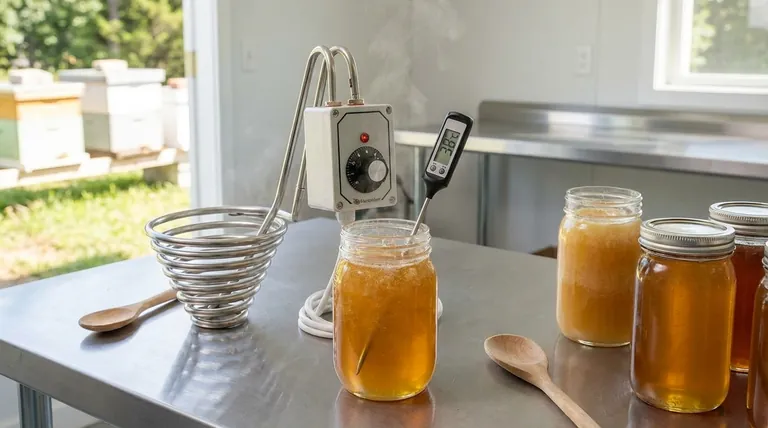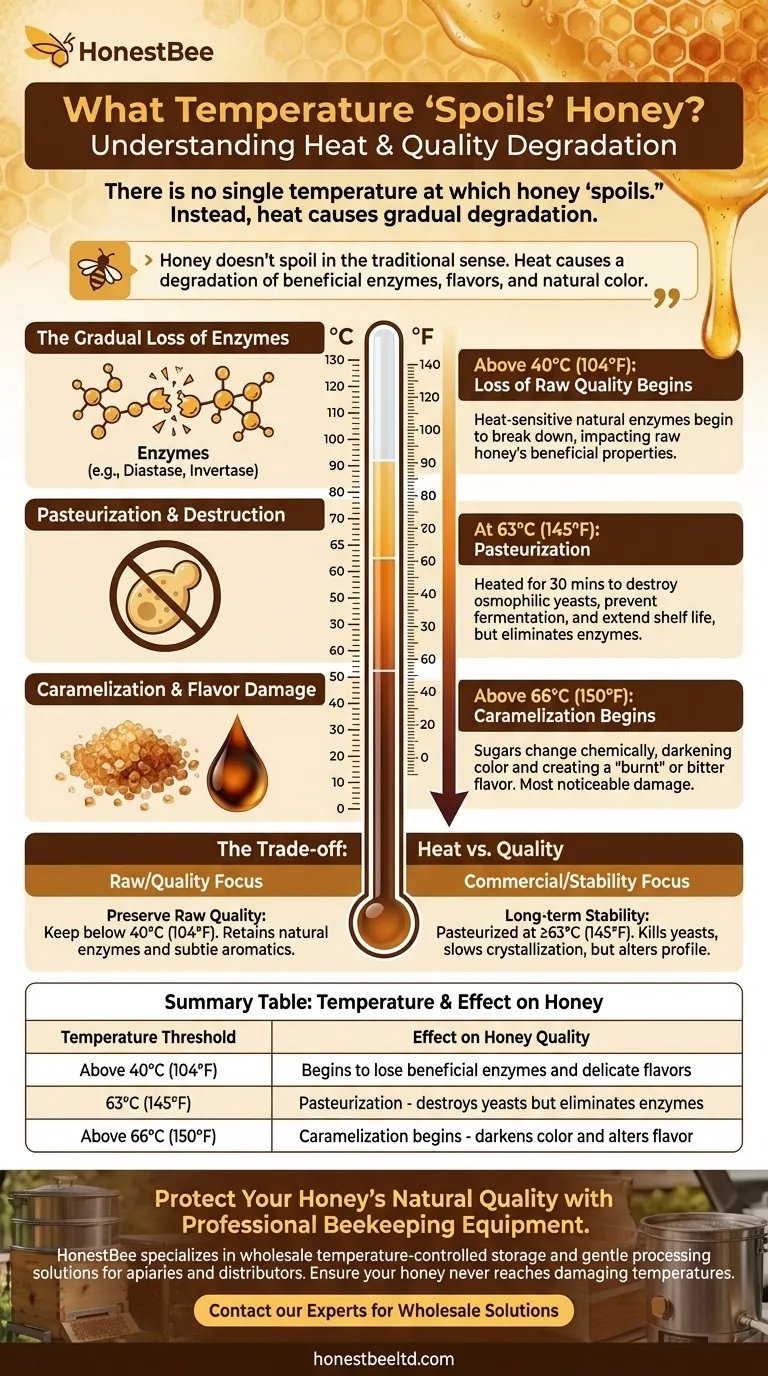There is no single temperature at which honey "spoils." Instead, honey begins to lose its unique enzymatic and aromatic qualities at temperatures above 40°C (104°F). More severe damage, like caramelization and significant nutrient loss, occurs between 60°C and 70°C (140°F to 158°F).
Honey doesn't spoil in the traditional sense of becoming unsafe to eat. Rather, heat causes a gradual degradation of its beneficial enzymes, delicate flavors, and natural color. The core issue isn't safety, but the loss of quality that makes raw honey unique.

What "Spoiling" Really Means for Honey
Honey is naturally antimicrobial and has an exceptionally long shelf life due to its low water content and high acidity. When we talk about heat "spoiling" honey, we are referring to the degradation of its valuable components.
The Gradual Loss of Enzymes
The most heat-sensitive components in raw honey are its natural enzymes, such as diastase and invertase.
These beneficial enzymes begin to break down when honey is heated above 40°C (104°F). This is the most critical threshold for those seeking to preserve honey in its raw, most natural state.
The Destruction of Yeasts
Commercial honey is often pasteurized to extend its shelf life and keep it liquid. This process involves heating the honey to at least 63°C (145°F) for 30 minutes.
This temperature effectively destroys the osmophilic yeasts that can cause fermentation, but it also eliminates the beneficial enzymes and alters the honey's delicate profile.
Caramelization and Flavor Damage
As temperatures rise further, the sugars in honey begin to change chemically.
At temperatures above 66°C (150°F), honey will start to caramelize. This darkens the color and changes the flavor, often creating a "burnt" or bitter taste. This is the most noticeable form of heat damage.
Understanding the Trade-offs: Heat vs. Quality
The decision to heat honey involves balancing convenience and preservation against the loss of natural quality.
Why Heat Honey at All?
Processors heat honey for two main reasons: to make it easier to filter and bottle, and to pasteurize it.
Pasteurization kills yeast spores, preventing any possibility of fermentation. It also slows down the natural process of crystallization, ensuring the honey remains liquid on the shelf for longer, which many consumers prefer.
The Inevitable Cost of Heat
Any application of heat is a trade-off. Even gentle warming to re-liquefy crystallized honey can cause some degradation if not done carefully.
The primary cost is the loss of the enzymatic activity and subtle aromatic compounds that define high-quality, raw honey. For many, these properties are the main reason for choosing honey over other sweeteners.
How to Handle Honey Based on Your Goal
Your ideal temperature limit depends entirely on what you value in your honey.
- If your primary focus is preserving raw quality: Keep your honey below 40°C (104°F) at all times, including during storage and when gently re-liquefying crystals.
- If your primary focus is long-term stability and preventing crystallization: You are effectively choosing pasteurized honey, which has been heated to at least 63°C (145°F).
- If your primary focus is simply using honey as a sweetener in hot drinks or baking: Acknowledge that the heat of your tea, coffee, or oven will instantly degrade its raw properties, but its function as a flavorful sugar will remain.
By understanding how heat affects honey, you can make deliberate choices to preserve the exact qualities you value most.
Summary Table:
| Temperature Threshold | Effect on Honey Quality |
|---|---|
| Above 40°C (104°F) | Begins to lose beneficial enzymes and delicate flavors |
| 63°C (145°F) | Pasteurization temperature - destroys yeasts but eliminates enzymes |
| Above 66°C (150°F) | Caramelization begins - darkens color and alters flavor |
Protect Your Honey's Natural Quality with Professional Beekeeping Equipment
As a commercial apiary or beekeeping equipment distributor, maintaining honey quality is crucial for your business success. HONESTBEE specializes in wholesale beekeeping supplies and equipment designed to help you preserve the natural enzymes, flavors, and aromas that make your honey exceptional.
Our temperature-controlled storage solutions and gentle processing equipment ensure your honey never reaches damaging temperatures. Whether you're focused on raw honey preservation or commercial-scale production, we have the reliable equipment to meet your specific needs.
Ready to optimize your honey processing and storage? Contact our experts today to discuss wholesale solutions that protect your product quality and enhance your profitability.
Visual Guide

Related Products
- Professional Thermostatic Conical Honey Melter
- 10L Stainless Steel Electric Honey Press Machine
- Honey Concentrating Vacuum Heating Thickening Machine Dehumidifier for Honey
- 8-Frame Electric Self-Reversing Honey Extractor Spinner for Commercial Honey Extraction Equipment
- Economy Small Scale Honey Dryer Dehumidifier Thickening Machine
People Also Ask
- What are the negative effects of overheating honey? Preserve Your Honey's Natural Quality
- Why is heating honey sometimes necessary? The Essential Guide to Processing & Quality
- Is it safe to heat crystallized honey? Restore Your Honey's Liquid State Safely
- What equipment is commonly used for heating and processing honey? Essential Tools for Every Beekeeper
- How to permanently decrystallize honey? Embrace Its Natural State for Maximum Quality



















